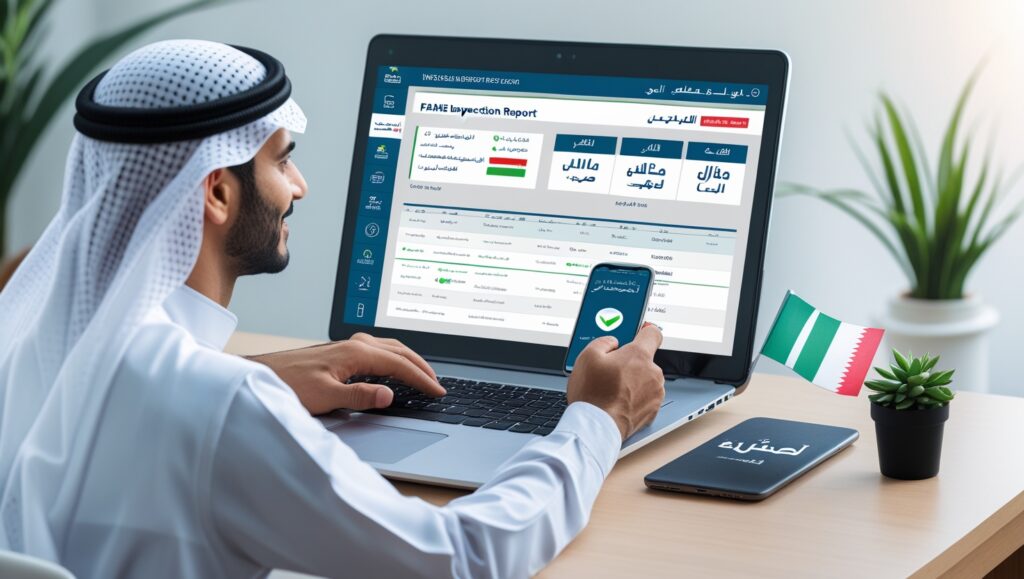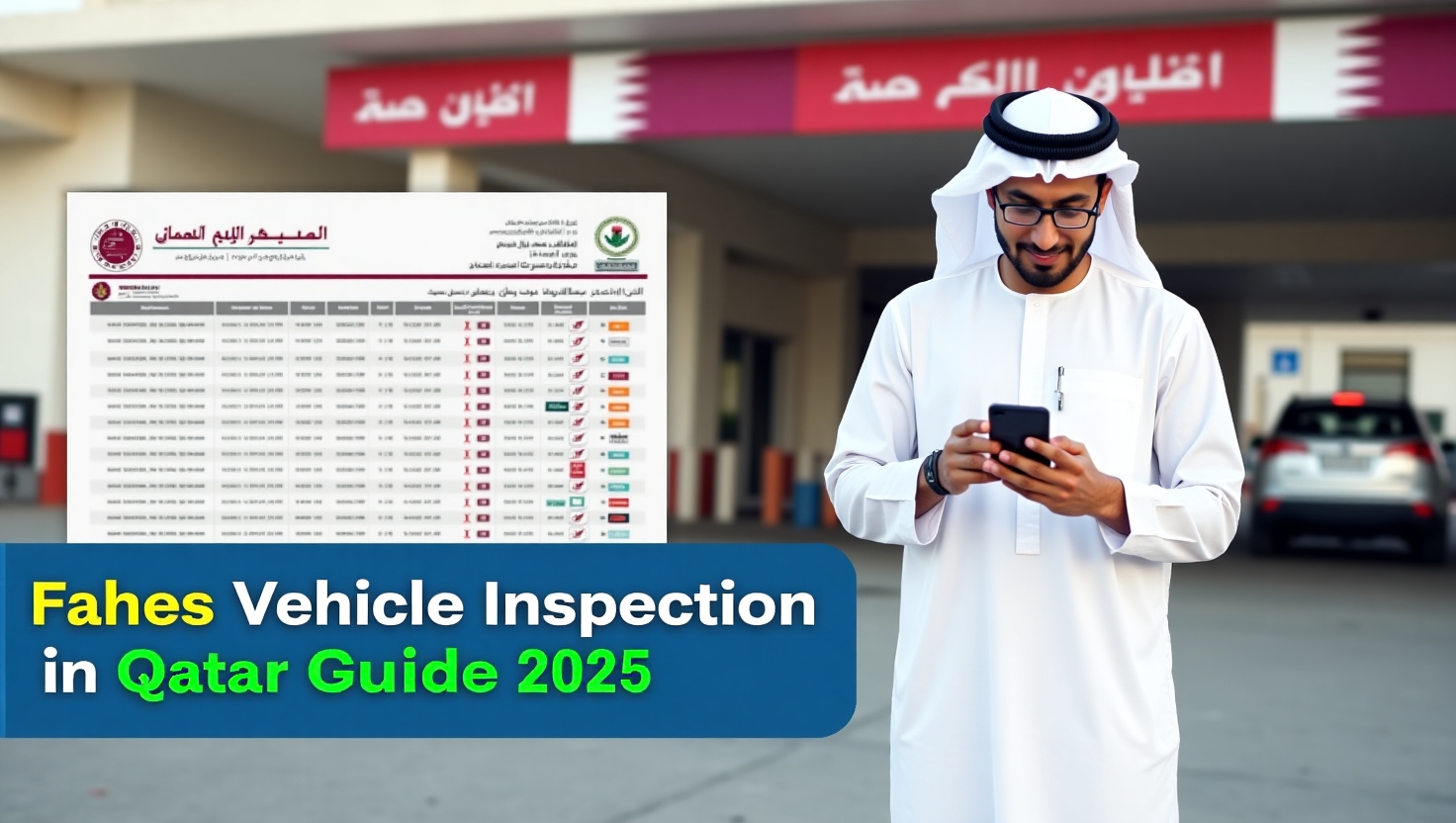Fahes is a mandatory annual vehicle inspection system in Qatar. Which ensures that vehicles are roadworthy and safe. This inspection is required every year after the vehicle has completed three years and is a condition for renewing the license.
Every private vehicle must undergo an annual inspection at an approved center. A registration card will not be issued without a successful inspection and to save time. You can book an appointment in advance through the WOQOD app.
What is Fahes in Qatar?
In Qatar, Fahes, part of WOQOD. This is the authorized body for mandatory vehicle inspections. The body inspects both light and heavy vehicles. Including cargo vehicles to ensure that they meet safety and environmental standards.

Fahes plays a key role in ensuring the roadworthiness and safety of all vehicles operating on Qatar’s roads. This system ensures that only quality and safe vehicles are allowed on the roads.
What Is Fahes Vehicle Inspection?
Fahes, also known as WOQOD Vehicle Inspection, is a mandatory inspection program in Qatar for vehicles over three years old that renews registration and ensures road safety and environmental standards.
The Purpose of Fahes Inspections
The aim of the Fahes inspection in Qatar is to ensure that all vehicles meet safety and environmental standards. These annual mandatory inspections, carried out under WOQOD, examine several important aspects, including brakes, tires, lights, exhaust, steering, and vehicle structure, to reduce accidents and losses on the road.
Legal and Policy Framework Behind Fahes Inspections
The legal framework for Fahes vehicle inspections in Qatar is based on ensuring road safety and environmental standards. It is mandatory for most vehicles every three years and is designed to test the fitness and emission levels of vehicles under Qatari laws, such as the Motor Vehicle Ordinance and Regulations.
When To Do Fahes Inspection?
Fahes inspections in Qatar are carried out annually for most vehicles, but their timing depends on the type of vehicle and its registration. Private vehicles are required to be inspected annually after the third year, while commercial vehicles, heavy trucks and motorcycles are required to be inspected annually from the first year.
Also Read Must: Click Here
When do you need Fahes vehicle inspection
In Qatar, most vehicles are required to undergo an annual FAHS inspection, but this depends on the type of vehicle and its registration. For private cars, the first inspection is required three years after registration, while taxis, rental cars and commercial vehicles are required to undergo an annual inspection from the first year. Vehicles imported from non-GCC countries must pass a FAHS inspection before registration.
If you are bringing a vehicle from abroad to Qatar, you must undergo a FAHS inspection before registration, however, vehicles imported from GCC countries, such as Saudi Arabia, Oman, or the UAE, are exempt from this requirement as their registration is acceptable in Qatar.
Commercial, company, or rental vehicles are required to have an inspection every year, whether they are new or used. Certain vehicles, such as heavy trucks and construction machinery, may require more frequent inspections. If the vehicle has been in a major accident and has been repaired, a repeat FAHS inspection may be required to verify its safety.
How often do you need Fahes
The FAHES inspection requirement in Qatar varies depending on the type of vehicle and its age. Here is a step-by-step explanation
1. Private Passenger Cars:
These cars are exempt from FAHES inspection for the first three years. However, from the fourth year onwards, an inspection is required every year to renew the registration (Istmara).
2. Taxis, rental cars and motorcycles:
Annual FAHES inspection is mandatory for these vehicles from day one, meaning there will be a check-up every year from the first year of registration.
3. Other vehicles (heavy, commercial, trailers):
Different rules may apply to these. Some may require more frequent inspections, so it is important to review the specific regulations for these vehicles.
Remember, the frequency of FAHES inspections depends entirely on the nature and age of your vehicle.
Types of Fahes Inspections
Fahes provides various types of vehicle inspections in Qatar, such as registration renewal, ownership transfer, export certificate, post-accident inspection, modified or classic car inspection. All these checks are done to ensure that vehicles can operate safely and according to legal standards on Qatari roads.

1.Periodic (Annual) Inspection:
This inspection is mandatory for most vehicles every year to verify their road safety and environmental quality.
2. Registration Renewal Inspection:
Conducted at the time of registration renewal to ensure that the vehicle meets all legal requirements.
3. Transfer of Ownership Inspection:
This inspection is required when a vehicle is transferred from one owner to another to verify its fitness.
4. Export Certificate Inspection:
This inspection is carried out if the vehicle is to be exported from Qatar to another country to obtain legal permission.
5. Post-Accident Inspection:
This inspection is carried out to verify the condition and roadworthiness of the vehicle involved in an accident.
6. Modified Vehicle Inspection:
This inspection is required for vehicles that have had their engine, body or other parts modified to ensure compliance with regulations.
7. Classic Car Inspection:
This inspection is done for older model vehicles to ensure that they meet the required standards despite their historical status.
Additional Facilities:
Fahes also provides mobile and specialized inspection facilities for corporate clients fleet vehicles, taxis, rental cars and motorcycles, the frequency of which may vary.
Fahes Inspections Requirement: Checklist to do for Inspection
To prepare for a Fahes vehicle inspection. It is essential that your vehicle fully meets safety and legal standards, especially brakes, lights, tires, and overall condition. Bring your registration card, Qatar ID and proof of insurance with you.
Arrive at the designated Fahes station on time. Register and pay the fee. Follow the inspector’s instructions during the inspection and wait for the results. Which you will receive via SMS.
Step 1: Download the Woqod App on your Mobile
To get the Woqod app on your mobile. Go to the Google Play Store or Apple Store and download the app. Click on the link below and select the correct store according to your phone’s operating system.
Step 2: Click on Fahes & Book Vehicle Inspection
To get the Woqod app on your mobile, go to the Google Play Store or Apple Store and download the app. Click on the link below and select the correct store according to your phone’s operating system.
Step 3: Enter your provided information
The sentence Enter your provided information is grammatically correct and has a clear meaning. Instructing the user to enter information that has been given to them or is available. Here provided is being used as an adjective that clarifies what kind of information is required.
Step 4: Select Station, time & date
Do you want to know how to select the train station, departure time and date? If yes then you can easily select the departure and destination station date and time by visiting an online platform like Bookme. Apart from that Google Maps also provides the facility to show transit options and train schedules where you can get results by entering your departure, destination, date and time.
Step 5: Receive Confirmational Message
A confirmation message is an automated notification that confirms that a recent action or transaction has been successfully completed. This message provides reassurance to the user and may also include relevant details, possible next steps, and contact information for support. Such messages are typically sent after an online process such as a purchase, booking, form submission, or subscription.
Appointments are required at three stations
The phrase appointments are required at three stations indicates that advance reservations are required for a service or appointment at certain locations. The nature of these stations and why appointments are required depends entirely on the context. Without additional detail. It is difficult to clarify the exact meaning of this statement.
Documents Required for Fahes Vehicle Inspection
To complete a FAHES inspection in Qatar, you will need to bring your Istamara (registration card), Qatar ID, and proof of insurance. If the vehicle was imported from abroad, original customs documents will also be required. Payment for the fee is usually made by debit or credit card.
Also Read Must: Click Here
Step 1: Pay Fees and Register your Vehicle
After reaching the inspection location, you will have to pay the prescribed fee for your vehicle registration through credit card, debit card or cash. During this time. The staff will also obtain your mobile number to send the result.
Step 2: Queue up for the Inspection
Queue for inspection indicates that people or objects have to wait their turn in an orderly manner during a checking or testing process. This term is commonly used in security, quality control, or other formal procedures, where order and discipline are essential. This phrase highlights the orderly and systematic nature of the process.
Step 3: Follow the directions for the inspection
It is important to follow the instructions of the staff, as the first stage will inspect the exterior of the vehicle, and the second stage will examine the internal structure such as the chassis. If the staff asks you to exit the vehicle, cooperate fully. This entire process is usually completed in less than 10 minutes.
Step 4: Wait for Inspection and Report Link
The phrase Wait for inspection and report link indicates that the report is in the process of being received after the inspection is complete. This is typically used in situations where a third party has inspected a vehicle, site, or equipment and the report needs to be provided to the relevant party via a link, often sent via email.
Detailed Technical Breakdown of Inspection Stages
Step 1: Exterior Inspection
This includes checking the vehicle’s lights, headlights, indicators, tire depth and alignment, and the body for rust or dents to ensure the exterior is in good condition and in good condition.
Step 2: Functional Test
This step checks the braking power suspension system (shock absorbers and springs), and vehicle emissions with advanced equipment to assess performance and environmental quality.
Step 3: Interior and Safety Check
This step ensures the functionality of safety features like seat belts, airbags and child locks so that the vehicle is fully safe on the inside as well.
Decoding the Fahes Inspection Report
Inspection Technology & Tools Used at Centers
The choice of inspection centers and the technology used depends on the nature of the inspection and the industry, and can vary greatly. Typically, flashlights and mirrors are used for visual inspection.
While calipers, micrometers and gauges are used for precise measurements. Advanced technologies such as 3D scanners, drones and robotic arms are also used for complex or high-level inspections.
Vehicle information
- Vehicle make and year
- Vehicle Identification Number (VIN)
- license plate number
- Total mileage on the odometer all of this information may be required during the inspection or registration process.
Inspection details
- Inspection Date
- Inspection Center Location:
- Technician ID
Inspection result
- Result Status (Pass or Fail)
- Detailed Inspection Result in Each Category
- Technical Experts Recommendations
Result of Emission test
- CO, HC and CO2 levels
- Compared to the prescribed acceptable limits
Results of brake efficiency
- Front and rear brake performance test
- Overall brake system condition analysis
Suspension & alignment results
- Wheel alignment accuracy check
- Measuring angles according to specific standards
Tire and Wheel condition
- Wheel alignment and overall condition difference
- Checking the tread depth of tires (tread depth)
Body & exterior check
- Check for rust or any damage to the body
- Inspect the overall condition of the vehicle body
Safety features evaluation
- Presence and condition of seat belts
- Presence and correct functioning of the airbag system
- Check of child safety locks (if present in the vehicle)
Recommendation for future
- Implement safety measures for passing vehicles
- Failed vehicles must pass re-inspection after repair
Interpretation of inspection results
- Pass: The vehicle meets all criteria.
- Fail: The vehicle has issues that need to be re-inspected after repair.
- Warning: There are minor defects, but the vehicle is temporarily acceptable.
How To Check Fahes Report Online
If you do not receive an SMS, you can also view your vehicle inspection results on the official website, or get the report via SMS sent immediately afterwards.

Go to the website
Open the official website of Fahes.
2. Select Online Report Search
Find the Online Report Search option on the main page and click on it.
3. Enter the information
Enter your vehicle’s plate number, plate type, QID number, and captcha code.

4. Click the Search button
After completing all the information, click “Search” to bring up the report
5. View or download the report
The report will appear on the screen, which you can view or print. After a successful inspection, the report can also be downloaded from the WOQOD website or the METRASH app.
What to Do If Vehicle Fails the Fahes Inspection
If your vehicle fails the FAHS inspection, it is important that you address all of the issues noted in the report as soon as possible. After repairs, if you re-inspect within 30 days, the process is usually free. However, if the vehicle fails the re-inspection, you will have to pay a fee again.
Remember that this free re-inspection is only valid for 30 days. After this period regardless of the initial report. The vehicle will have to undergo a complete new inspection and its regular fee will also apply. Therefore, it is better to get the repairs done on time and get the re-inspection done to avoid additional costs.
Common Reasons for Fahes Inspection Failure
There are many common vehicle failures in Qatar, including brakes, tires, lights and unauthorized modifications. Faded paint, rust, or visible leaks, or mechanical defects can also cause a vehicle to fail the inspection. The heat and sand in Qatar in particular, can affect the way a vehicle drives, increasing the chances of failure.
Brake problems:
Bad, worn or completely failed brakes, whose performance is not capable of safe driving on the road.
Tire problems:
Old, worn or non-standard tires, whose tread depth does not meet the safety standards for the diameter.
Faulty lights:
Bad or broken headlights, brake lights, tail lights or indicators, which can cause a hazard while driving.
Oil Leaks:
Engine, power steering, or gear oil leaks, which not only cause pollution but are also an indication of a technical malfunction.
Unauthorized Modifications:
Excessive tinting of glass, or modifications to the engine, exhaust, or body that are against the law.
Physical Damage:
Obvious dents, rust, or scratches on the body that call into question the structural integrity of the vehicle.
Steering Problems:
Stiffness in steering, misalignment, or control issues.
Safety Equipment Failure:
Damaged or inoperative seat belts, airbags, wipers, or cracks in the windshield.
Fahes Timings with Location
| Fahes Branch | Working Days | Inspection Timings | Gate Closes At |
| Al Mazrooah | Saturday to Thursday | 6:00 AM – 8:30 PM | 8:15 PM |
| Al Wakra | Saturday to Thursday | 6:00 AM – 8:30 PM | 8:15 PM |
| Al Wukair | Saturday to Thursday | 6:00 AM – 8:30 PM | 8:15 PM |
| Al Shahaniya | Saturday to Thursday | 6:00 AM – 8:30 PM | 8:15 PM |
| Al Khor | Saturday to Thursday | 6:00 AM – 8:30 PM | 8:15 PM |
| Mesaimeer | Sunday to Thursday | 6:00 AM – 5:45 PM | 5:15 PM |
| Wadi Al Banat | Sunday to Thursday | 6:00 AM – 5:45 PM | 5:15 PM |
| Industrial Area | Sunday to Thursday | 6:00 AM – 5:30 PM | 5:15 PM |
| Madinat Al Shamal | Wednesday to Thursday | 7:00 AM – 2:00 PM | 2:00 PM |
Choosing the Right Inspection Center
When you choose a Fahes inspection center, make a better decision by keeping the following steps in mind:
1. Select a location:
Choose the nearest testing center to your home or office to save time and avoid rush or traffic. Try to avoid peak hours.
2. Check slot availability:
Some centers have less rush and longer time slots. Be sure to check the real-time slot availability by visiting the website.
3. Verify services:
Each center provides services for specific types of vehicles. Check if the center offers the type of inspection or vehicle you need. Some centers also offer additional services.
4. Check amenities:
Many centers have amenities like cafes, parking, or comfortable waiting areas. Compare the websites for these details to have a better experience.
5. Prioritize comfort and convenience:
When choosing a center, prioritize your convenience, short wait times, and easy access so that the inspection process is smooth and stress-free.
Examples of Inspection Outcomes
Success story:
A motorcyclist successfully completed the FAHS inspection of his three-year-old vehicle in just a few minutes after a routine check-up.
Success from failure:
A commercial vehicle initially failed the inspection due to a brake defect, but after making the necessary repairs, it passed the inspection again within 30 days, free of charge (Source: Peninsula Newspaper).
Importance of Regular Maintenance
The FAHS inspection is not just a formal check, but it plays an important role in road safety, fuel efficiency, and accident prevention. For this, regular vehicle maintenance is essential. The following tips will help keep your vehicle in good condition
1. Stick to the schedule:
Always follow the maintenance schedule recommended by your mechanic to keep your vehicle in top condition.
2. Fix problems immediately:
If you notice any noise or technical issues, don’t ignore them. Small faults can become big over time.
3. Use quality parts and oils:
Cheap or poor quality oils and parts can cause long-term damage to the engine. Always use authentic brands.
5. Keep a record of receipts:
Keep all receipts for vehicle maintenance or repairs. These will not only be useful when reselling, but will also keep a clear record of service history.
6. Check tire pressure and fluids:
Check tire pressure, brake fluid, coolant, and other fluid levels every month. Also, inspect the headlights and indicators.
7. Keep the car clean:
Keeping the car clean and rust-free extends its lifespan and also leaves a positive impression during a Fahes inspection.
Environmental requirements in Qatar and the role of Fahes
The Fahes inspection is based on Qatar’s strict environmental regulations, where CO levels must be less than 0.5%, HC less than 220 ppm, and no visible smoke. If a vehicle exceeds these limits, it must be repaired and re-tested to control air pollution.
Fahes contributes to data analysis and policy-making
Fahes collects data from each inspection to identify common technical defects and more dangerous trends. This information is shared with authorities for road safety and environmentally friendly policies.
Steps towards sustainability
Fahes emphasizes recycling for environmental improvements, such as reusing used oil and safely disposing of harmful materials. At the same time, paper waste is reduced by using a paperless system and digital appointments, which promotes environmentally friendly practices.
Conclusion
The Fahes vehicle inspection in Qatar is not just a requirement for registration renewal, but a comprehensive system to ensure road safety, environmental protection, and compliance with traffic laws. To pass the inspection, the vehicle’s brakes, tires, lights, emissions, and body condition must be in excellent condition.
In case of failure, the vehicle can be re-inspected free of charge within 30 days. Different Fahes centers provide services with specific hours and facilities, so it is beneficial to make an appointment online before the inspection.
FAQs
What is Fahes?
Fahes is Qatar’s official vehicle inspection system managed by WOQOD, responsible for testing light and heavy vehicles to ensure they meet road safety and emission standards set by MOI and GCSM.
When to Do Fahes Inspection
You must do the Fahes inspection annually after your vehicle is 3 years old; however, commercial vehicles, taxis, and motorcycles require inspection every year from first registration.
How To Do Fahes Inspection in Qatar
To do Fahes inspection in Qatar, book an appointment via the WOQOD app or website, bring your Istimara, Qatar ID, and insurance. Then visit the selected Fahes center, pay the fee, and follow inspection steps as instructed.

Mr. Ajmal is an experienced writer and editor specializing in technology and digital trends. With over 5 years of experience, he produces insightful articles on emerging tech, consumer electronics, and digital culture. Ajmal holds a degree in journalism and is passionate about making complex topics accessible to readers.

